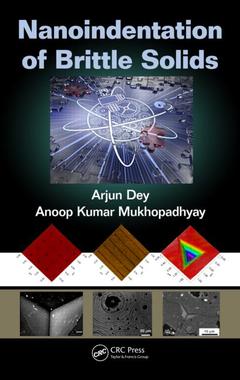Nanoindentation of Brittle Solids
Auteurs : Dey Arjun, Mukhopadhyay Anoop Kumar

Understanding the Basics of Nanoindentation and Why It Is Important
Contact damage induced brittle fracture is a common problem in the field of brittle solids. In the case of both glass and ceramics?and as it relates to both natural and artificial bio-materials?it has triggered the need for improved fabrication technology and new product development in the industry.
The Nanoindentation Technique Is Especially Dedicated to Brittle Materials Nanoindentation of Brittle Solids
- Discusses nanoindentation data analysis methods and various nanoindentation techniques
- Includes nanoindentation results from the authors? recent research on natural biomaterials like tooth, bone, and fish scale materials
- Considers the nanoindentation response if contact is made too quickly in glass
- Explores energy issues related to the nanoindentation of glass
- Describes the nanoindentation response of a coarse grain alumina
- Examines nanoindentation on microplasma sprayed hydroxyapatite coatings
Nanoindentation of Brittle Solids
Section 1 Contact Mechanics. Contact Issues in Brittle Solids. Mechanics of Elastic and Elastoplastic Contacts. Section 2 Journey Towards Nanoindentation. Brief History of Indentation. Hardness and Elastic Modulus. Nanoindentation: Why at All and Where?. Nanoindentation Data Analysis Methods. Nanoindentation Techniques. Instrumental Details. Materials and Measurement Issues. Section 3 Static Contact Behavior of Glass. What If the Contact is Too Quick in Glass?. Enhancement in Nanohardness of Glass: Possible?. Energy Issues in Nanoindentation. Section 4 Dynamic Contact Behavior of Glass. Dynamic Contact Damage in Glass. Does the Speed of Dynamic Contact Matter?. Nanoindentation Inside the Scratch: What Happens?. Section 5 Static Contact Behavior of Ceramics. Nanomechanical Properties of Ceramics. Does the Contact Rate Matter for Ceramics?. Nanoscale Contact in Ceramics. Section 6 Static Behavior of Shock-Deformed Ceramics. Shock Deformation of Ceramics. Nanohardness of Alumina. Interaction of Defects with Nanoindents in Shocked Ceramics. Effect of Shock Pressure on ISE: A Comparative Study. Section 7 Nanoindentation Behavior of Ceramic-Based Composites. Nano/Micromechanical Properties of C/C and C/C-SiC Composites. Nanoindentation on Multilayered Ceramic Matrix Composites. Nanoindentation of Hydroxyapatite-Based Biocomposites. Section 8 Nanoindentation Behavior of Functional Ceramics. Nanoindentation of Silicon. Nanomechanical Behavior of ZTA. Nanoindentation Behavior of Actuator Ceramics. Nanoindentation of Magnetoelectric Multiferroic Material. Nanoindentation Behavior of Anode-Supported Solid Oxide Fuel Cell. Nanoindentation Behavior of High-Temperature Glass–Ceramic Sealants for Anode-Supported Solid Oxide Fuel Cell. Section 9 Static Contact Behavior of Ceramic Coatings. Nanoindentation on HAp Coating. Weibull Modulus of Ceramic Coating. Anisotropy in Nanohardness of Ceramic Coating. Fracture Toughness of Ceramic Coating Measured by Nanoindentation. Effect of SBF Environment on Nanomechanical and Tribological Properties of Bioceramic Coating. Nanomechanical Behavior of Ceramic Coatings Developed by Micro Arc Oxidation. Section 10 Static Contact Behavior of Ceramic Thin Films. Nanoindentation Behavior of Soft Ceramic Thin Films: Mg(OH)2. Nanoindentation Study on Hard Ceramic Thin Films: TiN. Nanoindentation Study on Sputtered Alumina Films for Spacecraft Application. Nanomechanical Behavior of Metal-Doped DLC Thin Films. Section 11 Nanoindentation Behavior on Ceramic-Based Natural Hybrid Nanocomposites. Orientational Effect in Nanohardness of Tooth Enamel. Slow or Fast Contact: Does it Matter for Enamel?. Anisotropy of Modulus in Cortical Bone. Nanoindentation of Fish Scale. Section 12 Some Unresolved Issues in Nanoindentation. Indentation Size Effect (ISE) and Reverse Indentation Size Effect (RISE) in Nanoindentation. Pop-in Issues in Nanoindentation. Effect of Loading Rate on Nanoindentation Response of Brittle Solids. Measurement of Residual Stress by Nanoindentation Technique. Reliability Issues in Nanoindentation Measurements. Substrate Effect in ThinFilm Measurements. Future Scope of Novel Nanoindentation Technique. Conclusions. Common Abbreviations. Index.
Dr. Arjun Dey is a scientist at the Thermal System Group of ISRO Satellite Centre, Bangalore. Dr. Dey earned a bachelor’s in mechanical engineering in 2003, followed by a master’s in materials engineering from Bengal Engineering and Science University, Shibpur, Howrah in 2007. While working at CSIR-Central Glass and Ceramic Research Institute (CSIR-CGCRI), Kolkata, he earned his doctoral degree in materials science and engineering in 2011 from the Bengal Engineering and Science University, Shibpur, Howrah. The research work of Dr. Dey culminated in more than 120 publications to his credit.
Dr. Anoop Kumar Mukhopadhyay
Date de parution : 07-2014
15.6x23.4 cm
Date de parution : 04-2017
15.6x23.4 cm
Thèmes de Nanoindentation of Brittle Solids :
Mots-clés :
SEM; Nanoindentation Technique; Contact Mechanics; FESEM Photomicrograph; Mechanics of Elastic and Elastoplastic Contacts; SEM Photomicrograph; Journey Towards Nanoindentation; Nanomechanical Properties; Static Contact Behavior of Glass; Nanoindentation Experiments; Nanoindentation Data Analysis Methods; ISE; Brittle Solids; SLS Glass; Loading Rates; Microstructural Length Scale; Nanoindentation Cavity; Nanoindentation Behavior; Berkovich Indenter; Dense; Alumina Ceramics; Shear Bands; Local Microstructural Length Scale; Young’s Modulus Data; American Ceramic Society; Berkovich Nanoindenter; Scratch Groove; MAO Coating; Lowest Loading Rate; Nanoindentation Study



